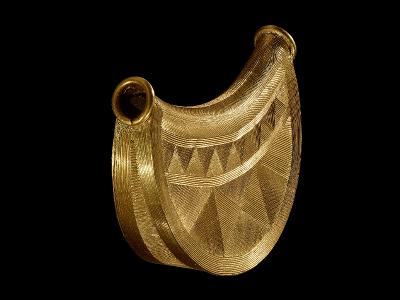Gathering Light
25 February, 2023

3,000-YEAR-OLD SUN PENDANT
FEATURES IN STUNNING NEW EXHIBITION
AN extraordinary 3,000-year-old sun pendant is to go on show in Sunderland as part of the British Museum's Spotlight loans tour.
The stunning piece, known as a gold bulla, is one of the most significant items of Bronze Age metalwork ever discovered in Britain and was found by a metal detectorist in the Shropshire Marches in May 2018.
Now the spectacular object is coming to Sunderland Museum & Winter Gardens as part of the prestigious A British Museum Loan Gathering light: A Bronze Age golden sun exhibition.
The free exhibition, which will be at the Museum from Saturday, February 25 to Saturday, June 3, will also include other Bronze Age gold artefacts, from a gold lunula (amulet) discovered in an Irish bog to a hoard of Cornish torcs (neck rings) and rings. The exhibition will also feature Bronze Age objects from the North East.
In Britain, the Bronze Age period lasted from around 2150BC until 800BC. Solar symbolism was a key element of mythology and belief during this period: the sun charted the day and provided life. This Spotlight Loan reveals the importance of the sun to the lives of Bronze Age ancestors, including the use of precious gold to depict the golden star and its centrality to their beliefs in this period.
The sun pendant features an exceptionally rare depiction of the sun - not previously seen on objects found in Britain. The pendant celebrates the life-giving power of the sun during the time of the earliest metalworkers and is a hugely significant addition to the understanding of the art and iconography of Bronze Age Britain.
Meanwhile, the stunning gold, crescent-shaped lunula, likely worn around the neck and dating from between 2400-2000BC, making it at least 4,000 years old, is named because it resembles a 'little moon'.
Discovered in a bog near Mangerton, Ireland in July 1842, this is one of only around 100 lunula examples that have been found in western Europe. More than 80 of these 'little moons' come from Ireland, indicating a distinctively Irish cultural form. The collar was made by beating gold into a very thin sheet then decorated with a complex finely-incised geometric triangle pattern with considerable skill and was probably worn as jewellery or a ritual item. Such skilled craftsmanship and the presence of gold suggests that this lunula was a prestigious item.
Another gold bulla found in Ireland, dating between 1150-750BC and globular purse shaped rather than half-moon shaped, will also be on display as part of the Spotlight Loan. A similar age to the Shropshire sun pendant, the appearances and shape of the two bullas are very different. Similarly decorated with geometric patterns, though much less elaborate, it contains a cylindrical opening along the top which suggests it may have been worn as a pendant.
The exhibition includes the first loan of the Towednack hoard, a series of gold objects discovered in Cornwall in 1931. An ancient stone hedge concealed two torc necklaces, four arm rings and two pieces of unfinished gold material. The objects date from 1400BC-1100BC, making them at least 3,100 years old.
One of the torcs consists of three twisted bars of fine gold, delicately woven together. The other larger gold torc is much simpler and more typical of the type worn in Ireland. The bracelets would also have been commonplace and remain in different stages of completion with two seemingly awaiting polishing and smoothing. The unfinished gold bars are bent, suggesting that they were raw material from a goldsmith intended to be a bracelet.
Completing the tour exhibition is an open-ended, gold plated ring found in Londonderry, Northern Ireland. Also around 3,000 years old, the ring is made of tin alloy core, wrapped in gold foil and decorated with concentric rings of impressed dots. The pattern of vertical, parallel incisions on the outer edge is like that of the Shropshire sun pendant and shows parallels between Bronze Age communities.
Neil Wilkin, Curator, Early Europe at the British Museum said: "The Shropshire sun pendant is an internationally significant object, reflecting the artistic brilliance of communities from the deep past and the social and religious connections that spanned western Europe.
"Throughout the Bronze Age, Cornwall played a critical role in providing Britain, Ireland and Continental Europe with important raw materials, as well as producing stunning finished objects. The opportunity to bring the sun pendant to Cornwall, the source of so much material wealth and stylistic inspiration is therefore thrilling."
Jo Cunningham, Exhibitions, Collections and Archives Manager at Sunderland Museum, added: "Sunderland and its surrounding area are rich in archaeological evidence left by people who lived here in the long distant past.
"The Museum has many items found when a burial mound, was excavated at Hasting Hill in 1911. The finds include swords, tools, food vessel, urns and burial cists. Although there is nothing as spectacular as the Shropshire sun pendant these beautiful objects, skilfully made by the people of Wearside, tell their own fascinating stories ... and who knows what is yet to be discovered."
For more information about the exhibition and supporting family activity programme visit sunderlandmuseum.org.uk
Gathering light is generously supported by the Dorset Foundation, in memory of Harry M Weinrebe, with additional funding coming from The Austin & Hope Pilkington Trust for accompanying activities.




